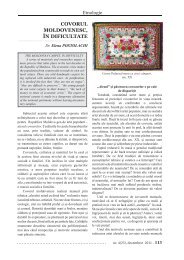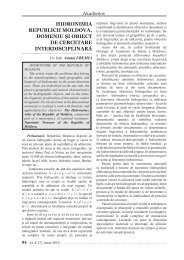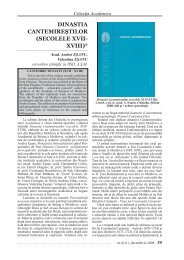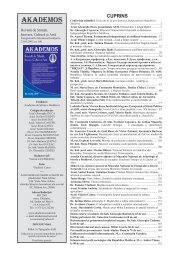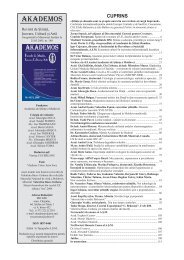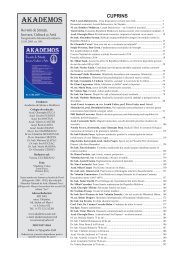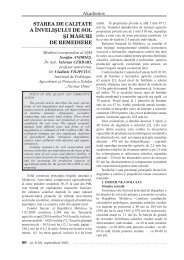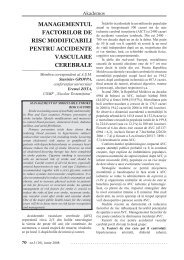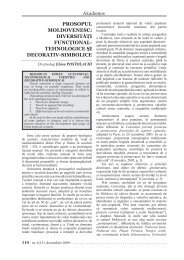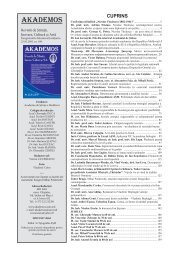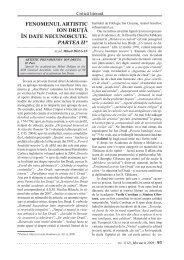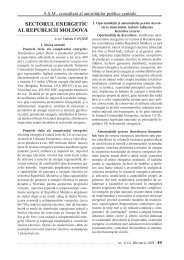Academos 2 2010.indd - Akademos - Academia de ÅtiinÅ£e a Moldovei
Academos 2 2010.indd - Akademos - Academia de ÅtiinÅ£e a Moldovei
Academos 2 2010.indd - Akademos - Academia de ÅtiinÅ£e a Moldovei
You also want an ePaper? Increase the reach of your titles
YUMPU automatically turns print PDFs into web optimized ePapers that Google loves.
Istorie<br />
TRICOLORUL<br />
NAŢIONAL.<br />
Introducere în<br />
simbolistica<br />
vexilologică<br />
Dr., conf. cercet. Vlad MISCHEVCA<br />
NATIONAL TRICOLOR. INTRODUCTION IN<br />
VEXILOLOGICAL SYMBOLISM<br />
A retrospective view of the historical evolution<br />
of the tricolor fl ag was imperative at the end of<br />
80’s of the past century and it remains as currently<br />
today, because are heard voices that <strong>de</strong>ny the right of<br />
citizens of Moldova to the Romanian national colors.<br />
The symbols in the history of human civilization in<br />
general, and the national Stately ones in particular,<br />
have held and have a particularly importance. The<br />
national symbols and symbolic culture have a high<br />
semiotic status. The spirituality of a nation is retained<br />
in its heraldic symbols.<br />
The history of Romanian symbols conclusively<br />
confi rms the thesis acording to which, such as the<br />
treasury, the bases of national symbols consists from<br />
old elements gained from prenational stage. The main<br />
function of the national symbols - the fl ag, the coat<br />
of arms, the hymn - had been and remain the ethnic<br />
strengthening, the unity and mobilization of the nation..<br />
Presenting summarily the Moldovan history of the<br />
tricolor, that of our fl ags (the typology and hierarchy<br />
fl ags) and of the national colors, we can conclu<strong>de</strong><br />
that the studying and the knowledge of the history<br />
of national stately symbols, the fl ag and emblem,<br />
remains forward currently and necessary, because<br />
any nation’s past, the glorious <strong>de</strong>eds of their ancestors<br />
inclu<strong>de</strong> those heraldical symbols or signs that were<br />
painted on their fl ags and coats of arms.<br />
Drumul cunoaşterii lumii trece prin înţelegerea<br />
simbolurilor, a sensului lor ascuns.<br />
Simbolismul medieval este un mijloc <strong>de</strong> asimilare<br />
intelectuală a realităţii. A. Gurevici<br />
Scopul acestui articol este <strong>de</strong> a<br />
contribui şi pe această cale – aca<strong>de</strong>mică – la<br />
popularizarea Zilei Drapelului <strong>de</strong> Stat – 27 aprilie<br />
– sărbătoare instituită recent prin lege. Aceasta<br />
urmează să re<strong>de</strong>a compatrioţilor noştri sentimentul<br />
civic, legat <strong>de</strong> unul dintre simbolurile i<strong>de</strong>ntitare<br />
esenţiale – Tricolorul naţional, românesc. Atribut<br />
şi simbol al Patriei, Tricolorul reprezintă statul şi<br />
expresia fiinţei noastre naţionale. 1<br />
1<br />
Vezi: Mischevca Vl. Simbolurile Republicii Moldova, în<br />
Destin românesc. Revistă <strong>de</strong> istorie şi cultură. (Chişinău-Bucureşti).<br />
2001, (8) nr.1, p.97-119.<br />
În condiţiile în care Drapelul <strong>de</strong> Stat este<br />
contestat şi batjocorit în Transnistria, fiind<br />
consi<strong>de</strong>rat până şi la Chişinău <strong>de</strong> unii comunişti<br />
drept un „drapel fascist”, se impune să <strong>de</strong>zvăluim<br />
a<strong>de</strong>văratele lui semnificaţii istorice şi naţionale, să-l<br />
onorăm şi să-l arborăm fără reţineri, pretutin<strong>de</strong>ni!<br />
Fie că participăm la evenimente sportive, concerte<br />
sau la sărbătorile naţionale, fie acasă, la serviciu<br />
sau când plecăm în străinătate, tricolorul naţional<br />
trebuie să ne fie nelipsit!<br />
20 <strong>de</strong> ani reprezintă o perioadă suficientă pentru<br />
a privi evenimentele <strong>de</strong>ja <strong>de</strong> pe poziţia cercetătorului<br />
echidistant, cu o analiză şi abordare a subiectului<br />
mai puţin politologică sau publicistică, punând<br />
accentele pe realizările şi problemele simbolisticii<br />
naţionale. 2 O privire retrospectivă a evoluţiei istorice<br />
a Drapelului Tricolor a fost imperativă la sfârşitul<br />
anilor ‘80 ai secolului trecut şi tot atât <strong>de</strong> actuală<br />
rămâne astăzi, <strong>de</strong>oarece se mai aud voci care neagă<br />
dreptul cetăţenilor Republicii Moldova la culorile<br />
naţionale ale românilor.<br />
Bătălia pentru Tricolorul naţional, <strong>de</strong>clanşată <strong>de</strong><br />
către intelectualitatea moldavă, s-a încununat, până<br />
la urmă, cu un succes răsunător la 27 aprilie 1990.<br />
Să ne amintim, că la acea dată RSSM se prezenta<br />
ca un stat butaforic, cu simboluri impuse sau, mai<br />
bine zis, inventate <strong>de</strong> pe un calapod străin – cel al<br />
imperiului sovietic…<br />
Forţa argumentului istoric a fost <strong>de</strong> o aşa putere,<br />
încât nici măcar guvernarea PCRM (2001-2009)<br />
nu a îndrăznit să revizuiască Stema şi Drapelul <strong>de</strong><br />
Stat, chiar dacă a şi încercat să atace duşmăneşte<br />
Drapelul tricolor, etichetând-ul drept unul „străin”.<br />
Cert este că Tricolorul nu a învrăjbit societatea<br />
şi nu ne-a <strong>de</strong>zbinat. Un fals argument rămâne opinia<br />
celor <strong>de</strong> la Tiraspol şi nu doar, precum că Limba<br />
română şi Drapelul naţional ar fi fost factorii care<br />
au în<strong>de</strong>părtat malurile Nistrului şi au alimentat<br />
conflictul transnistrean.<br />
„Omul este o fiinţă simbolică”<br />
De la bun început remarcăm că în istoria<br />
civilizaţiei umane simbolurile, în general, şi cele<br />
naţional-statale, în special, au <strong>de</strong>ţinut şi <strong>de</strong>ţin un<br />
loc <strong>de</strong>osebit <strong>de</strong> important în viaţa societăţii şi a<br />
indivizilor săi. Astfel, în istoriografia <strong>de</strong> specialitate,<br />
simbolurile sunt consi<strong>de</strong>rate expresie a culturii,<br />
i<strong>de</strong>ilor şi valorilor umane, întrucât „omul este o fiinţă<br />
simbolică, el trăind prin intermediul simbolurilor şi<br />
graţie lor”. 3<br />
Deşi nu ne propunem scopul <strong>de</strong> a pune în<br />
2<br />
Mischevca Vl., Negrei I. Tricolorul şi tradiţia istorică, în<br />
Literatura şi arta, nr. 18, 3.05.1990, p.3.<br />
3 Рубцов Н.Н. Символ в искусстве и жизни: философские<br />
размышления. – М., 1991, с. 147; Drîmba O. Istoria culturii şi<br />
civilizaţiei. Vol.III. – Bucureşti, 1990, p. 654-658.<br />
nr. 2(17), iunie 2010 - 3



